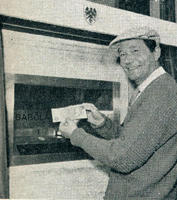
Actor Reg Varney using the world’s first ATM in Enfield Town
On January 28, 1905, Armenian-American inventor Luther George Simjian was born. Simjian probably is best known for his invention of the Bankmatic Automated Teller Machine. His more than 200 inventions also included the TelePrompter, a self-posing portrait camera, automatic postage metering equipment, and an indoor golf practice range.
Early Years
Luther Simjian emigrated to the United States in 1920 and started to work as a photographer at the age of 15 and later was occupied as a laboratory photographer at the Yale School of Medicine. In 1928, Simjian became the director of the photography department and invented machines like a projector for microscope images.
In New York City, Luther Simjian self-posing portrait camera. The photographed person could see and improve their own image in a mirror before the photo was taken. Simjian founded Photoreflex to sell the camera and later sold the invention. He renamed the company Reflectone, inspired from a further invention by Simjian, a cosmetic chair with movable mirrors, where one could see their own body from all perspectives.
The Automated Teller Machine
One of Simjian’s most famous inventions is the Bankmatic Automated Teller Machine. The first functioning ATM was built in 1939 by Simjian and put into operation in the early 1960s as a bankograph by the City Bank of New York. In the US patent record, Luther George Simjian has been credited with developing this “prior art device”. Specifically his 132nd patent (US3079603), which was first filed on 30 June 1960 (and granted 26 February 1963). The Bankograph was an automated envelope deposit machine (accepting coins, cash and cheques) and did not have cash dispensing features. However, the operation was not particularly successful, which was due not so much to technical difficulties as to a lack of acceptance by public customers. The device was dismantled after half a year of trial operation. It turned out that most people using the machines were apparently (according to Simjian) prostitutes and gamblers who didn’t want to deal with tellers face to face. This way, Luther Simjian missed out the financial success and fame of inventing the ATM.
How to Authenticate?
Adrian Ashfield invented the basic idea of a card combining the key and user’s identity in February 1962. This was granted UK Patent 959,713 for “Access Controller” in June 1964 and assigned to W. S. Atkins & Partners who employed Ashfield. He was paid ten shillings for this, the standard sum for all patents. It was originally intended to dispense petrol but the patent covered all uses
The still common principle of authentication by comparing an entered PIN with the number stored on a customer card was conceived in 1965 by the British engineer James Goodfellow, who holds several patents for it. Despite these early successes, it still took a long time for this technology to achieve a major breakthrough. When the first generation of ATMs came onto the market, the banks were initially hesitant to use them. The reasons for this were the technical design of the devices, the inadequate security and the insufficient information capacity of the card used. All this allowed only a limited use for the customers of the respective financial institution operating the ATM.
It is widely accepted that the first cash machine was put into use by Barclays Bank in its Enfield Town branch in North London, United Kingdom, on 27 June 1967. This instance of the invention is credited to the engineering team led by John Shepherd-Barron of printing firm De La Rue. Transactions were initiated by inserting paper cheques issued by a teller or cashier, marked with carbon-14 for machine readability and security, which in a later model were matched with a six-digit personal identification number (PIN).
There are no hard international or government-compiled numbers totaling the complete number of ATMs in use worldwide. Estimates developed by ATMIA place the number of ATMs currently in use at 3 million units, or approximately 1 ATM per 3000 people in the world.
Further Inventions
However, during World War II Simjian’s Optical Range Estimation Trainer, a flight simulator made from mirrors, several light sources as well as miniature airplanes. The inventor was able to sell more than 2000 of these devices. He founded multiple companies and kept inventing further devices including a teleprompter, medical ultrasound devices, a remote-controlled postage meter, a golf simulator and a meat tenderizer. Seven months before his death, Luther Simjian received the patent on a process for improving the sound of wood for musical instruments. At the age of 92, he got his last patent on a process for improving the sound of wood for musical instruments, seven months before his death in 1997.
History Of ATM – Automated Teller Machines | Modern World Inventions, [5]
References and Further Reading:
- [1] Luther Simjian at the New York Times
- [2] Short Biography of Luther Simjian
- [3] The Money Machines: An account of US cash machine history; By Ellen Florian, Fortune.com
- [4] ATM at Wikidata
- [5] History Of ATM – Automated Teller Machines | Modern World Inventions, Modern World Inventions @ youtube
- [6] Luther George Simjian at Wikidata





